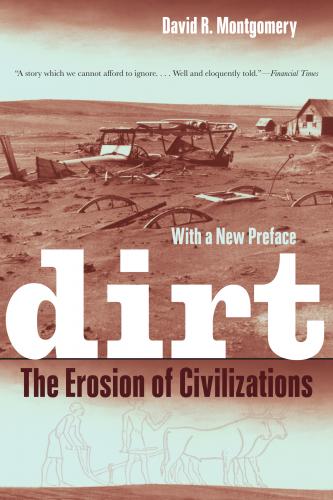Dirt. David R. Montgomery
>
The publisher gratefully acknowledges the generous contribution to this book provided by the General Endowment Fund of the University of California Press Foundation.
Dirt
THE EROSION OF CIVILIZATIONS
With a New Preface
David R. Montgomery
UNIVERSITY OF CALIFORNIA PRESS
BERKELEY LOS ANGELES LONDON
Also by David R. Montgomery
King of Fish: The Thousand-Year Run of Salmon
University of California Press, one of the most distinguished university presses in the United States, enriches lives around the world by advancing scholarship in the humanities, social sciences, and natural sciences. Its activities are supported by the UC Press Foundation and by philanthropic contributions from individuals and institutions. For more information, visit www.ucpress.edu.
University of California Press
Berkeley and Los Angeles, California
University of California Press, Ltd.
London, England
First paperback printing 2008
© 2007, 2008, 2012 by The Regents of the University of California
Library of Congress Cataloging-in-Publication Data
Montgomery, David R., 1961-.
Dirt : the erosion of civilizaton / David R. Montgomery
p. cm.
Includes bibliographical references and index.
ISBN 13: 978-0-520-27290-3 (pbk : alk. paper)
1. Soil science—History. 2. Soils. 3. Soil erosion. I. Title.
S590.7.M66 2007
631.4'9—dc22 2006026602
Manufactured in the United States of America
19 18 17 16 15 14 13 12
10 9 8 7 6 5 4 3 2 1
The paper used in this publication meets the minimum
requirements of ANSI/NISO Z39.48-1992 (R 2002)
(Permanence of Paper).
For Xena T. Dog, enthusiastic field assistant, dedicated receptionist, and very best friend—walk with me forever, sweet girl
CONTENTS
10 / LIFE SPAN OF CIVILIZATIONS
PREFACE
The twin problems of soil degradation and erosion have plagued humanity since the dawn of agriculture. Although these problems are mostly of our own making and well within our power to solve, citizens, the media, and politicians don't seem to take them as seriously as volatile financial markets, climate change, or any number of other societal challenges. And yet, how we treat land, how we treat the soil, is fundamental to the health and survival of modern civilization. I wrote this book because over the course of several decades, I came to see soil as a resource every bit as important as things we would all recognize as essential. But who, really, thinks of soil—of dirt—as a vital resource?
In college I was trained as a geologist, advised to ignore or dismiss soil as “overburden” unworthy of serious attention. In graduate school I specialized in geomorphology, the study of processes shaping and influencing topography, focusing on the factors that control where stream channels begin. In studying the interplay of runoff and erosion on forested hillslopes, I came to appreciate how tree roots helped stabilize soils and how the roots of fallen trees pried up and mixed rock into the dirt to make new soil.
But it wasn't coursework or fieldwork that first exposed me to the idea that soil erosion contributed to the decline and fall of ancient societies, it was the very thing you now hold in your hands, a book. I was perusing the bargain bin at the university bookstore and picked up Topsoiland Civilization, a long out-of-print volume written by two soil conservation service scientists in the 1950s. The price was right, so I bought it. It was one of those moments when an inspired story burrows into a receptive brain. Everything clicks and you see things differently. I found the narrative gripping, and it stayed with me throughout my geological studies. Soil, of all things, brought down ancient societies that abused their land and paid the ultimate price, leaving a legacy of degraded, worn-out fields and impoverished descendents.
As I investigated the evolution of landscapes around the world, I began to more fully comprehend this fundamental, yet widely unrecognized problem confronting humanity. We are degrading and eroding the world's soils far faster than they form. We are running down our stock of fertile topsoil, the one thing we absolutely need to support civilization in the long run. Viewed globally, that is quite a feat.
In the 1990s, I read an influential paper arguing that human activity had become a significant global factor in moving soil and rock. This was news to me, because geologists regard exploding volcanoes and shifting tectonic plates as the forces shaping the planet, not people. Human activity doesn't figure into thinking about deep time and earth history because we arrived on the scene far too recently. And yet, as we remodel our world at a phenomenal pace geologically speaking, we are neglecting to conserve and protect the critical resource right beneath our feet. Instead, the topsoil lost from agricultural fields becomes soil out of place—in other words, dirt.
If Earth had come with an operating manual, the first chapter might be titled something like “How to Protect Soil, Mother of All Life.” It would portray soil as the dynamic interface between geology and biology, the bridge between the dead world of rock and the bustling realm of life.
When
